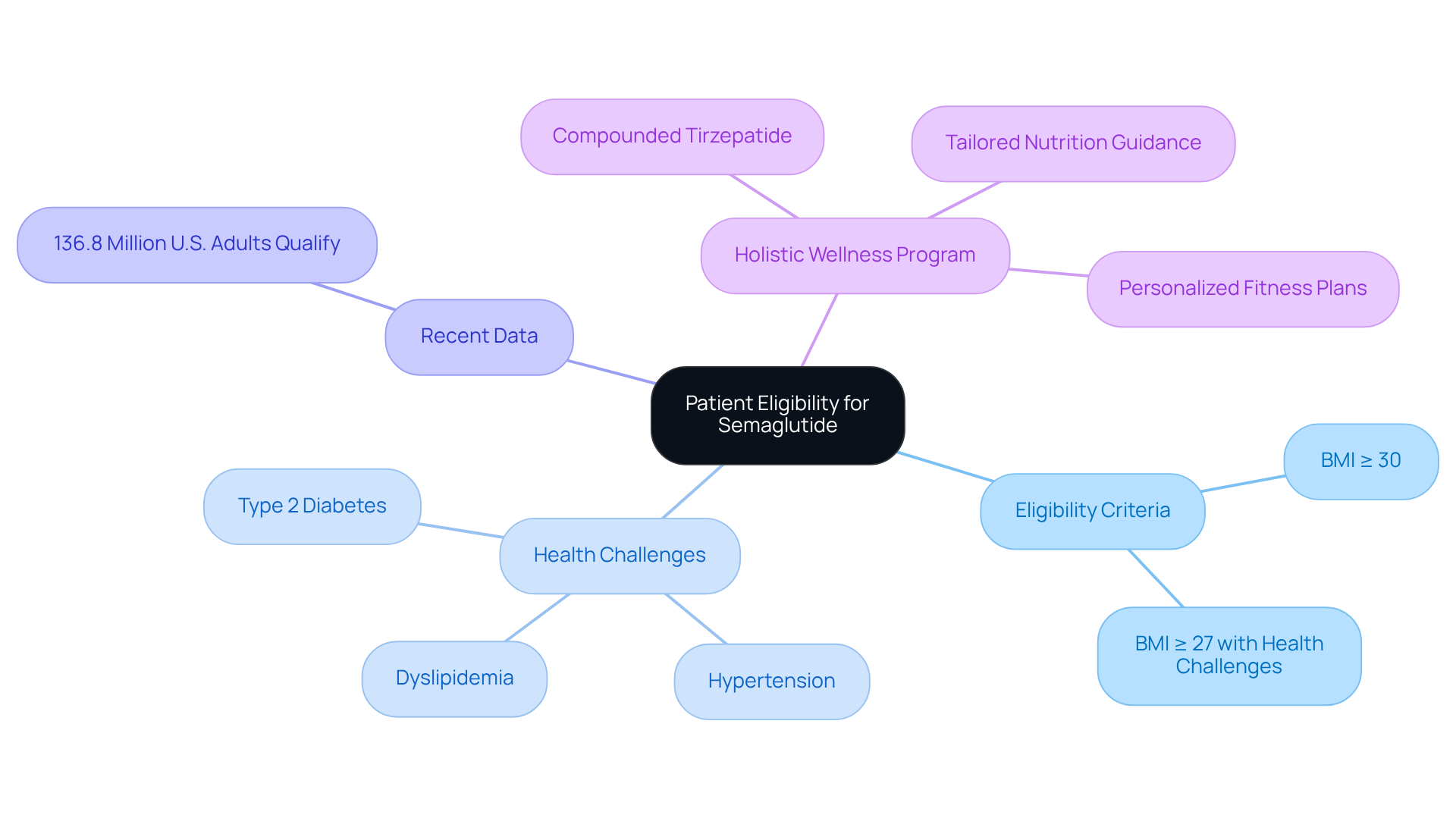Overview
This article highlights essential steps for the safe and effective prescription of semaglutide, a valuable tool in managing type 2 diabetes and supporting weight loss through its GLP-1 receptor agonist mechanism. We understand that navigating these health challenges can feel overwhelming, which is why we are here to provide guidance. The article details:
- Patient eligibility criteria
- Recommended dosages
- Monitoring strategies
All aimed at ensuring healthcare providers can optimize patient outcomes.
Moreover, it emphasizes the importance of managing potential side effects, reinforcing that healthcare professionals are equipped to support their patients through this journey. Together, we can achieve your health goals, fostering a community of understanding and care.
Introduction
Semaglutide has emerged as a groundbreaking option in the realm of weight management and type 2 diabetes treatment, offering remarkable results for many individuals. We understand that navigating these challenges can feel overwhelming, and this guide is here to support healthcare providers with essential steps for the safe and effective prescription of this powerful medication.
It’s crucial to grasp its mechanism, identify patient eligibility, and be aware of potential side effects. Yet, with its notable benefits come important considerations.
What challenges might arise in ensuring the optimal use of semaglutide? Together, we can explore how providers can navigate these hurdles to maximize patient outcomes and foster a journey of success.
Understand Semaglutide: Uses and Mechanism of Action
Semaglutide is a glucagon-like peptide-1 (GLP-1) receptor agonist that plays a significant role in managing type 2 diabetes and supporting weight loss. By mimicking the GLP-1 hormone released in the gut after meals, it stimulates insulin secretion, inhibits glucagon release, and slows gastric emptying. This combination helps reduce appetite and increase feelings of fullness.
Clinical studies reveal that semaglutide can lead to remarkable weight loss. Participants have achieved a total body mass loss (TBML) of 13.4% over 12 months, while those without type 2 diabetes saw an even greater TBML of 16.9% during the same period. Notably, 22% of individuals experienced a weight loss of 20% or more. However, it’s essential to recognize that over 50% of individuals reported side effects, primarily gastrointestinal symptoms like nausea, gas, and diarrhea.
It is crucial for healthcare providers at Minimal to understand these mechanisms and potential side effects in order to prescribe semaglutide. This knowledge enables them to communicate the extensive benefits and expected outcomes to individuals considering how to prescribe semaglutide. Additionally, monitoring individuals for the effects of oral medications taken with Wegovy is vital, along with awareness of contraindications such as the risk of thyroid C-cell tumors.
The elevated success rate of the program, with many clients reportedly losing up to 20% of their body mass based on data from over 70,000 individuals, underscores the need to prescribe semaglutide as a valuable tool in obesity management. This aligns seamlessly with Minimal’s holistic approach to personalized weight loss solutions and comprehensive healthcare. Remember, together, we can achieve your goals, and we’re here to support you every step of the way.
Determine Patient Eligibility: Criteria for Prescribing Semaglutide
To effectively prescribe semaglutide, healthcare providers must assess not only the patient’s body mass index (BMI) but also their overall health profile. Many adults, particularly those with a BMI of 30 or greater, or those with a BMI of 27 or higher who experience weight-related health challenges like type 2 diabetes, hypertension, or dyslipidemia, may be eligible for treatment that healthcare providers might prescribe semaglutide. Recent data indicates that around 136.8 million U.S. adults qualify based on these criteria, highlighting the significant need for effective management solutions.
At Minimal, a holistic wellness brand, we understand the complexities of weight management. That’s why we offer a comprehensive loss management prescription program that includes not just a specific medication but also:
- Compounded Tirzepatide
- Personalized fitness plans
- Tailored nutrition guidance
We believe that a thorough medical history is crucial to identify any contraindications, such as personal or familial instances of medullary thyroid carcinoma or multiple endocrine neoplasia syndrome type 2. Regular follow-ups are vital to monitor progress and adjust treatment plans as needed. This organized approach ensures safety and enhances the potential benefits of the medication, which has been shown to be effective in promoting weight loss and reducing cardiovascular risks among suitable individuals for whom doctors may prescribe semaglutide.
Together, we can navigate this journey towards wellness, ensuring that every step is taken with care and consideration for your unique needs.
Prescribe Semaglutide: Dosage, Administration, and Monitoring
Starting a weight loss journey can feel overwhelming, but we’re here to support you every step of the way. The suggested initial dosage to prescribe semaglutide for managing body mass is 0.25 mg, administered subcutaneously once a week for the first four weeks. This initial dosage is designed to help your body acclimate to the medication, easing you into the process.
After this initial period, you may find your healthcare provider will prescribe semaglutide at an increased dose of 0.5 mg weekly, with the possibility of further increments up to a maximum of 2.4 mg weekly. This adjustment depends on how your body responds and your tolerance levels. It’s important to remember that you are not alone in this; many have successfully navigated similar paths and achieved their goals.
To make the most of your treatment, try to administer your injection on the same day each week, at any time that suits you, with or without meals. Keeping track of your weight, blood sugar levels, and any potential complications is crucial. Regular follow-up meetings, typically every 1-3 months during the early stages of treatment, ensure you receive the essential support and modifications needed to enhance your results. Together, we can achieve your goals and celebrate your progress.
Manage Side Effects and Contraindications: Ensuring Patient Safety
If you’re considering semaglutide, you might be concerned about some of the common side effects that can arise when doctors prescribe semaglutide. Frequent adverse reactions often include gastrointestinal issues like nausea, vomiting, diarrhea, and constipation. While these symptoms can be uncomfortable, it’s reassuring to know that they are generally mild and tend to improve over time. To help manage these reactions, we encourage you to:
- Eat smaller, more frequent meals
- Stay properly hydrated
It’s also important to monitor for serious adverse reactions, such as pancreatitis and thyroid tumors. Being aware of warning signs, like severe abdominal pain or swelling in the neck, can help you identify more serious conditions early. If you have a personal or family history of medullary thyroid carcinoma or multiple endocrine neoplasia syndrome type 2, it’s crucial to discuss these contraindications with your healthcare provider.
Regular follow-ups are essential in this journey. These check-ins should include evaluations of your overall health and any new side effects you may experience. Together, we can ensure the safe and effective use of semaglutide. Did you know that approximately 82% of participants in clinical trials reported gastrointestinal disorders? This statistic highlights the importance of proactive management strategies.
Many patients have found success in mitigating these side effects through dietary adjustments and open communication with their healthcare providers. Remember, you’re not alone in this journey—together, we can achieve your health goals. We’re here for you, and with the right support, you can navigate any challenges that arise.
Conclusion
Understanding the safe and effective use of semaglutide is vital for healthcare providers who wish to support patients in managing type 2 diabetes and achieving weight loss. This medication, a GLP-1 receptor agonist, provides significant benefits by enhancing insulin secretion and promoting a feeling of fullness. Yet, it is important to remember that potential side effects must be carefully managed to ensure patient safety and satisfaction.
The article outlines essential steps for prescribing semaglutide, such as:
- Determining patient eligibility based on BMI and health conditions
- Recommending appropriate dosages
- Monitoring for side effects
It highlights the importance of a holistic approach to weight management, integrating medication with personalized fitness and nutrition plans. Regular follow-ups and open communication between patients and healthcare providers are crucial for navigating challenges and optimizing treatment outcomes.
Ultimately, the journey toward weight loss and improved health is a collaborative effort. By leveraging the benefits of semaglutide while remaining vigilant about its side effects and contraindications, healthcare providers can empower patients to achieve their health goals. Embracing this proactive approach not only enhances individual well-being but also contributes to a broader movement toward effective obesity management and comprehensive healthcare solutions. Remember, together, we can achieve your goals, and we’re here for you every step of the way.
Frequently Asked Questions
What is semaglutide and how does it work?
Semaglutide is a glucagon-like peptide-1 (GLP-1) receptor agonist used to manage type 2 diabetes and support weight loss. It mimics the GLP-1 hormone released in the gut after meals, stimulating insulin secretion, inhibiting glucagon release, and slowing gastric emptying, which helps reduce appetite and increase feelings of fullness.
What are the weight loss results associated with semaglutide?
Clinical studies show that participants using semaglutide achieved a total body mass loss (TBML) of 13.4% over 12 months, while individuals without type 2 diabetes experienced an even greater TBML of 16.9%. Additionally, 22% of individuals lost 20% or more of their body weight.
What side effects are commonly reported with semaglutide?
Over 50% of individuals reported side effects, primarily gastrointestinal symptoms such as nausea, gas, and diarrhea.
Why is it important for healthcare providers to understand semaglutide’s mechanisms and side effects?
Understanding semaglutide’s mechanisms and potential side effects enables healthcare providers to prescribe it effectively, communicate its benefits and expected outcomes to patients, and monitor individuals for the effects of oral medications taken with Wegovy.
What are the contraindications associated with semaglutide?
One key contraindication is the risk of thyroid C-cell tumors, which healthcare providers must be aware of when prescribing semaglutide.
How successful is semaglutide in obesity management?
The program has a high success rate, with many clients reportedly losing up to 20% of their body mass, based on data from over 70,000 individuals, highlighting semaglutide’s value in obesity management.





















